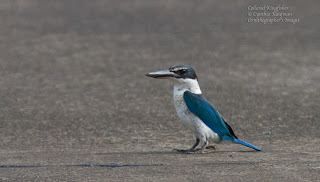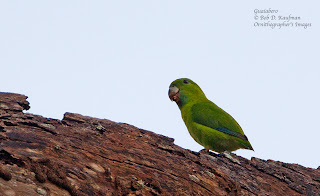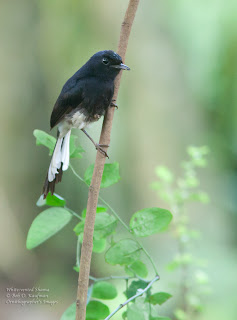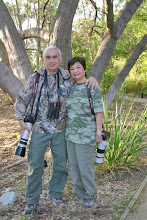skip to main |
skip to sidebar
A little after 1 pm we decided to leave the Indigo-banded Kingfishers of Villa Escudero alone. Tirso had an appointment at two and Peter wanted to try birding the streets of Hacienda Escudero. As soon as Cynthia and myself boarded Peter's car it rained. No, not a trickle but a downpour. That made the three of us happy. Why? Two reasons: One - what would we have done if that happened while we were shooting the kingfishers? our precious equipment would have taken an unwelcome bathing. And who knows what havoc that calamity would have wrought. Two: this deluge of a rain will soon stop and when it does birds will certainly come out and we will be there to meet them.
Come out they did. When the rain finally dwindled to a drizzle, an impatient (and hungry) Pied Bush Chat started diving at some unfortunate insect from its perch.
The shower came to a complete stop. Birds started popping out. They were so intent in drying themselves up that we were able to get reasonably close. Like this Long-tailed Shrike.
Along the road, Paddyfield Pipits and White-browed Crakes were shaking off their wetness.
As is their habit, a Lesser Coucal was rising to meet the sun.
The sun eventually peeped through the dark clouds as a heavily laden Collared Kingfisher prepared for takeoff.
And the Philippine Coucal proudly welcomed Phoebus into its realm.
Patience is a virtue. A virtue that every single bird photographer should possess. For the three of us, that virtue was pushed to its limit.
Come early, we were told, and you will see them. So at 6:30 am we were lined up, cameras ready, cool riverine waters flowing at our feet. Nothing.
Nothing except for a totally unexpected benefaction. We were all eying a mossy rock. Upon this rock the Indigo-banded Kingfisher perches to hunt for food. Many photographs from our friends attested to that fact. However, it was a different bird that suddenly alit on that particular piece of stone that protrudes from the fluvial flow. It was a Common Emerald Dove!
Then there were the attention starved Philippine Magpie Robins who would drop by and make all kinds of poses - all within perfect photographic distance. We tried to ignore them as we wanted to concentrate on the kingfishers. They were just so persistent that we had no choice but to give in to temptation of these avian Circes.
A short coffee break, a quick look at the slumbering Philippine Scops Owl and we're back at our posts. Friends Peter Ting, Tirso Paris and myself resumed our stake-out. My wife, Cynthia, decided not to join us. She and our gracious host, Carmela Balcazar, were engaged in some serious conversation. Now joining us was Ronald, Villa Escudero's resident bird guide. Thanks to his super sharp eyes, we were finally able to get good looks at our quarry, and local celebrities, the Indigo-banded Kingfishers. But these were just fleeting glimpses.
That was pretty much the routine for the whole morning. Lunch time. We savored the delicious food and talked about more pleasant birding experiences.
It was after lunch that the action began to liven up. Sightings of the kingfishers became more frequent and closer. We had some satisfactory photo-ops.
Love them Indigo-banded Kingfishers - they come and they go.
As per our friend, Prof. Tirso's suggestion we moved from the TREES to the IRRI (International Rice Research Institute) ricefields. It was a big change from craning our necks to looking below. From the frustration of not seeing the birds we wanted to see to getting good looks at our target species - lots of them even!
Not surprisingly, it was Prof. Tirso who first spotted them. We were all "dude" birding (birding from our vehicles) and Prof. Tirso drove ahead to scout the area for the Greater Painted Snipes. Soon we got a text message from him: "GPS here near where I'm parked". Tina and myself drove our respective cars to where he was. Bingo! Although the birds were skulking behind the tall grass, we still had nice views of several individuals.

But before this fortuitous event, we were driving on the muddy roads next to the ricefields looking for anything interesting to photograph. Once in a while we would stop when we would spot some movements on the rice stalks. Now why on earth did these birds always show up on Cynthia's side is beyond me. Also on occasion we would both get off the car and scout the surrounding areas on foot. We were returning to our vehicle after one these walking explorations that I saw my wife with a smirk on her face. I can tell from her expression that she had something to show me. I was already forming in my mind the new blog that I will perhaps be writing which would most likely be "Better Half Part 2". And of course, she did. It was an almost close-up shot of a Buff-banded Rail.
Add to that the photos she took earlier from her side of the car: A Paddyfield Pipit.....
---- and a gorgeous Zitting Cisticola
I had my "revenge" of sorts in a most interesting, even embarrassing way. I was answering the call of nature when to my surprise a White-browed Crake suddenly flew from nowhere and landed on the wire fence a few feet in front of me. I had with me Cynthia's camera at that time, the shorter 300mm lens. Let's just say I got a quick shot before the bird crake realized I was there and startled, it flew off.
Before we even realized it, it was almost noon. Prof. Tirso, gracious host that he already was invited us to a sumptuous lunch at Kamayan sa Palaisdaan at the nearby town of Bay.
From a distance....we watched....emitting sighs of frustration.
Frustration because the birds were quite far even for our long lenses. Frustration because the birds we hoped to see were a no-show. Yet despite these, the sighs of frustration were only of minor consequence compared to the delight of the company we shared. The passage of time becomes a blur when you are with friends who share the same passion with you.
We were at the "deck" next to the TREES (Tropical REsources and Ecosystems Sustainability) Hostel in the campus of the University of the Philippines in Los Banos (UPLB).
It all started when our dear friend Maia reported in her blog that the ficus trees near the hostel were now fruiting (and therefore attracting a lot of birds). That certainly perked our interest. It turned out that we were not the only ones. Monday afternoon we got a text message from fellow bird photographer and good friend, Tina Mallari. She wanted to know if we would like to join her at UPLB early Tuesday morning. We of course said yes. I then contacted Prof. Tirso Paris who resides close to the UPLB. He promised to meet us at the TREES hostel grounds.
For about three hours all four of us: Tina, Prof. Tirso, Cynthia and myself watched the fruiting trees but were frustrated by the non-appearance of the hoped for Luzon Hornbills. Thankfully the tall dead tree next to the ficus was where the action was. It was like a relay station where one species would perch, spend a few minutes, then fly off - only to be replaced by another species - sometimes consisting of more than one individual. Now let me explain here that the said dead tree was very tall, therefore the birds that perched on it were practically dots on our camera viewfinders - despite the 500mm lenses that Tina and I were using.
The first group were the noisy balicassiaos, calling raucously, their glossy dark feathers glowing in the early morning sun.
As the Balicassiaos left, the endemic Guaiaberos made their appearance.
The tiny green birds were replaced by the Coppersmith Barbets giving out their monotonous hammering call. The Barbets were the frequent occupiers of this particular dead tree. They would return to the tree every now and then and oftentimes bullying whoever was at that place at that particular time.
The Stripe-headed Rhabdornis came next - only when the Barbets were out of sight.
Finally, a lifer! I didn't realize it until we were already home and I was checking our photographs. When I first saw it, I thought it was the Grey-streaked Flycatcher. But Grey-streaked Flycatchers are migrants - was the thought that kept bothering me. So when I looked at the Kennedy Guide, I realized that what I saw was actually a Striped Flowerpecker. There were indeed a huge flock of flowerpeckers feasting on the fruits of the ficus tree. I saw Orange-bellied and Red-keeled among them. It is very likely then that one of those could be a Striped Flowerpecker. My suspicion was further confirmed by our friend, Adri Constantino, when I showed him the photo I took.
It was half-past ten and still no signs of the Luzon Hornbills. Having had our fill of the company of birds in the TREES parking area, Prof. Tirso suggested we go to IRRI next and see what it has in store for us birdwise.
I admit that despite our research from the internet and from friends there were still a lot of glitches during our first time trip to Puerto Princesa, Palawan. For one thing it had been raining off and on throughout our stay there and then there was the permit to the Underground River fiasco. (Please see my previous blogs for details). Nevertheless, we still got three lifers and managed to see some beautiful birds. We also had pleasant experiences at the local hotels.
We were picked up at the airport by the hotel van. We booked at the Palo alto Bed & Breakfast for June 25th and then on June 27th. Our room was in excellent condition with hot showers, refrigerator, complimentary bottled water, aircon and complimentary breakfast (you choose from Filipino, American, or local - all of which are very delicious). Their in-house restaurant, Salakot, opens at 6 am. However when we left for Sabang at 5;30 the following morning, they even packed our complimentary breakfast for us! The hotel itself is relatively new (it opened in 2011). It has a native look to it and the foundations were made of a Acacia manguim taken from a responsibly maintained local plantation. The hotel uses solar energy to heat their water. It being away from the city center, and thus far the noise and pollution make it a perfect nature getaway. Palo Alto also offers free van transportation to and from the city/airport. From the hotel's two decks you can view the surrounding trees and hear the sound of bird songs. We saw about 15 species of birds within the surrounding area. Everyone at Palo Alto, from their cordial owner, Guido Ylaya, the desk personnel, Bernadette & Girlie, to their driver, Mervin, were very nice, helpful and made sure our stay was enjoyable.



In Sabang we stayed at the Daluyon Beach and Mountain Resort. Again, the staff, particularly May and Grace at the reception area and Eugene, the carabao cart driver, were exceedingly helpful. Rydell and Julbert, the waiters at the in-house Pawikan Restaurant, were the epitome of service and friendliness.
Badjao Restaurant in Puerto Princesa sits atop a mangrove forest. Fresh sea breezes kept the place comfortably cool. The dishes, particularly the seafood, were gastronomical delights. The waiters were friendly and courteous and the prices were just right.
Kalui Restaurant in Puerto Princesa, touted as the number one in the city, for us was a bit disappointing. Compared to Badjao's expansive feel, Kalui, although bigger in space, seemed cramped and dark. The wall decor was composed of various works of art some of which were quite prurient in nature, which makes this place not really family-friendly. The waiters tend to be aloof and just focused on serving food without a hint of congeniality. The dishes themselves were just so-so.
Logistics:
Palo Alto Bed & Breakfast - P3,000.00 a night. (complimentary breakfast included)
Private Van (provided by Lexus Shuttle Service) to Sabang - P3,000.00
Daluyon Beach & Mountain Resort - P4,424.00 a night (complimentary breakfast included)
Public Van from Sabang - P140.00 per person = P280.00
June 25 dinner, Badjao Restaurant - P522.00 (senior discounted)
June 26 lunch, Pawikan in Daluyon Resort - P490.00 (senior discounted)
June 26, dinner, Pawikan in Daluyon Resort - P350.00 (senior discounted
June 27, lunch at Badjao - P370.00 (senior discounted)
June 27, dinner at Kalui - P390.00
Tricycle fares - P80.00 used twice = P160.00
Van to Iwahig (provided by Palo alto B&B) - P1,200.00 (half day)
"Angel" in a Jolly Mood
We did not have an "angel" with us this morning. But we were in a jolly mood - the sun was shining, the birds were chirping.
Our last day in Puerto Princesa. Our plane doesn't leave until 1 pm so we have the whole morning to bird the surrounding area of our hotel. It was a reprise of what we have seen three days ago. With a little bonus! We were surprised to see an Ashy Drongo perched on a wire overlooking a tiny corn patch teeming with Chestnut Munias.
The Brown-throated Sunbirds were enjoying the sunshine that had been missing the past several days.
The juvenile white-vented Shama was still in its usual hangout. This time it was joined by an adult.
Even the Pygmy Flowerpeckers were bolder than usual.
Indeed time flies when you're having fun. Soon it was time to go. We bade fond farewells to the hotel staff who had been so nice and helpful to us.
We'll be back!
"Angel" Come Lately
Let me start off by saying that our stay in Sabang was disastrous in terms of birding. The idiom "when it rains, it pours" certainly rang true for us and literally too. When we inquired at the desk of the hotel where we were staying regarding the tours they were offering to the Subterranean River we were told that they were no longer doing so. Apparently permits were needed to be able to enter the park area and the place to get the permits was in the city of Puerto Princesa, some 80 kilometers away. From what we learned, a 30-day advance notice was required to get such permits.
We also declined to take the Mangrove Paddle Boat tour despite the promise of possibly seeing a lot of birds along the mangroves. For one thing it had been raining off and on and without sufficient cover, the odds of our cameras getting splashed by waves and raindrops were frightening.
Under these circumstances we decided to return to Puerto Princesa as early as possible. The public van leaves at 7:30 am we were informed. At 7:15 we were aboard the carabao-pulled cart which would takes us from the hotel to the van terminal. Eugene, our carabao cart driver, was curious about us. He said that he saw us yesterday toting cameras with long lenses.
"We're bird photographers", we explained. He inquired if we have taken the tours. In so many words we poured out our frustrations.
"You could have taken other options", he told us.
"Like what?" We were genuinely curious.
"Well, you could have taken the mountain trail behind Robert's Hotel. It's an easy trail through a dense forest. There were plenty of birds seen there. Or you could have taken the trail going to the zip line. You will have to wade a little through very shallow waters though then go up a forested hill. Many birds there, too!"
"But would that involve some strenuous hiking? We're no longer spring chickens, you know."
"Oh, you both can definitely handle those trails. Besides you'd be stopping every now and then to take pictures of birds, won't you?" He certainly made a lot of sense.
"Oh, Eugene!" I exclaimed. "Why did we meet you only now!"
It was too late to turn back, having checked out of the hotel already and we have already reserved a space on the van going to Puerto Princesa.
We were brooding on our seats as we left Sabang. Things even got worse when our van suffered a flat tire delaying our trip by some 30 minutes. We arrived at Puerto Princesa about 10 am, checked in at Palo Alto Bed and Breakfast and then went to Badjao Restaurant for lunch.
Once again, we hoped to see the Stork-billed Kingfisher that supposedly inhabits the mangroves nearby. Once again, it was a no-show. After lunch we lingered outside the restaurant while waiting for the van that will take us to Iwahig to arrive. I texted birding friend, Gabs Buluran, and inquired where he found the Copper-throated Sunbird the last time he was here. Near the tricycle stand where the trees with red flowers are and next to where the Pied Fantails hang around, he told me. Pied Fantails, ok we got that. But where were the red flowers? Cynthia and I were in this mystified mood when rain fell.
Guido Ylaya, the owner of Palo Alto B&B, was very kind enough to let us use the hotel van and driver to take us to Iwahig at a very reasonable price. We've been trying to negotiate for transportation to take us to the famous Penal Colony but the quotes we were getting were bordering on the ridiculous.
Mervin, the driver, was the polar opposite of Frederick, our driver to Sabang. Where Frederick was laconic, Mervin was loquacious - and quite knowledgeable. Current events, history, name it, and he would expound on those subjects with admirable details. Our trip to Iwahig then was never boring and despite the intermittent rain we still saw some birds along the way - most of which were badly photographed.
At Balsahan - the only place where we were allowed to go - it was dreary and scary. The locals who were manning the "pool" area were too cloying it seemed. It was when we left the "pool" area that we saw something blue fly across the road and alit on the tree nearby. Cynthia and I jumped out and saw a pair of Asian Fairy Bluebirds!
Then came a loud "wek-wek-wek". It was through our efforts at locating the source of that sound that we discovered the Balsahan trail - the widely known birding spot here in Iwahig. Unfortunately it was drizzling again and the despite Cynthia hearing a cacophony of bird songs, the place was too dark and wet to see any birds at all. It was now getting late and we still have a 6 o'clock reservation at Kalui Restaurant so we told Mervin that it was time to go.
On the way back, we passed by some newly fallowed ricefields. To our surprise, Spotted doves were plentiful. Mingling with them were Watercocks - a family of them. A Paddyfield Pipit was another surprise.
 |
| Spotted Dove |
 |
| Watercock |
 |
| Watercock - male |
 |
| Paddyfield Pipit |
As if on cue, just as we finished taking pictures of these birds, heavy rain fell again from the skies. We arrived at Kalui just in time, thanked Mervin and then endured a so-so dinner at an overrated restaurant.
The Reluctant "Angel"
He always grunted whenever he gave an affirmative answer to our yes or no question.
"Is it OK if we ask you to stop every now and then?"
"Um."
Can you drive a little slower? We need to listen and look for birds."
"Um."
His name was Frederick (that's what he told us). We found out two days later that his real name was Tito. Anyway, Frederick (that's what we will call him in this blog) was the driver who will take us to Sabang. He was quite prompt though, arriving earlier than the 5:30 am departure time that we scheduled. It was still dark at that time and we didn't mind that he drove at quite a fast pace through the still deserted roads.
It was when a cloudy dawn broke through that we asked him to slow down. We could tell that he was quite reluctant to do so despite the fact that we hired him to drive for us until noon time. When I saw a bird perched on an electric wire I asked him to stop. I looked through my binoculars and dismissed it as "just" an Asian Glossy Starling. Besides it was so backlit that all my shots were trash material. Frederick was looking ahead, ennui written all over his face. I asked him to move on.
"Um." he replied.
About 30 minutes later, Cynthia yelled, "Stop!" "Stop!" She heard some bird calls. We stopped. I scanned the clump of low trees and saw some movement. Pictures were taken, albeit only of "documentary" quality.
Let me digress for a while. I did not bring my 500mm lens on this trip on purpose. With all the uncertainties that comes along with a first time visit I thought it prudent to just bring the 300mm. Then there were the intermittent rains, of course, and I would hate my big lens getting soaked in rainwater.
Back to the "documentary" photo. Until now I couldn't figure out what bird it was. It looks like a bulbul but the rufous wing, yellow eyes and streaked throat sort of threw me off.
An hour-and-a-half later with no birds seen or heard along the way we decided to stop at the view deck at Sitio Buenavista to have some breakfast. Our hotel in Puerto Princesa, Palo Alto B & B, was kind enough to pack our free breakfast for us. We gladly shared it with Frederick. Somehow his mood changed after that.
Another thirty minutes down the road and it rained again. We made a stop next to some roadside stalls curiously named Jazz Souvenirs and Cafeteria.
Across the road the trees were teeming with bird calls. Braving the downpour and ensconced in my camouflaged raincoat I got a photo of our first lifer of the trip - the Black-headed Bulbul.
Joining this lovely species were their drabber cousins, the Ashy-fronted Bulbul and lots of Palawan and Pygmy Flowerpeckers. Olive-backed Sunbirds completed the foraging flock.
Still further down the road were Large-billed Crows and Spotted Doves vainly trying to get their feathers dry. But what got Frederick really excited was when we saw the Coucal spreading its bright rufous wings as the sun emerged from the dark clouds. At first we thought that it was just another Philippine Coucal which Cynthia and I have seen many times before doing the exact same thing. Only when I checked the Kennedy Guide later did I realize that Philippine Coucals are not found in Palawan! Instead the bird that we just saw was actually a Greater Coucal - another lifer for us!
Five hours after we left Puerto Princesa we arrived at our hotel in Sabang. Frederick was quite chatty on the final leg of our trip and seemed to have developed an interest in birds himself.
I think a good hearty breakfast can change a man into an "angel".
Update: The mystery bird was a Striped Tit-Babbler. Another lifer! Thanks, Adri Constantino and Desmond Allen!














































